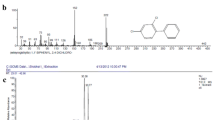Abstract
A mixed microbial community, specially designed todegrade a wide range of substituted aromaticcompounds, was examined for its ability to degrademono-chlorophenols as sole carbon source in aerobicbatch cultures. The mixed culture degraded 2-, 3-, and4 -chlorophenol (1.56 mM) via a meta- cleavagepathway. During the degradation of 2- and3-chlorophenol by the mixed culture, 3-chlorocatecholproduction was observed. Further metabolism was toxicto cells as it led to inactivation of the catechol2,3-dioxygenase enzyme upon meta- cleavage of3-chlorocatechol resulting in incomplete degradation.Inactivation of the meta- cleavage enzyme led toan accumulation of brown coloured polymers, whichinterfered with the measurement of cell growth usingoptical denstiy. Degradation of 4-chlorophenol by themixed culture led to an accumulation of5-chloro-2-hydroxymuconic semialdehyde, themeta- cleavage product of 4-chlorocatechol. Theaccumulation of this compound did not interfere withthe measurement of cell growth using optical density.5-chloro-2-hydroxymuconic semialdehyde was furthermetabolized by the mixed culture with a stoichiometricrelease of chloride, indicating complete degradationof 4-chlorophenol by the mixed culture via ameta- cleavage pathway.
Similar content being viewed by others
References
Adams RH, Huang CM, Higson FK, Brenner V & Focht DD (1992) Construction of a 3-chlorobiphenyl-utilizing reconbinant from an intergeneric mating. Appl. Env. Micro. 58: 647–654
Arnesdorf JJ & Focht DD (1994) Formation of chlorocatechol meta-cleavage products by a Pseudomonad during metabolism of monochlorobiphenyls. Appl. Env. Micro. 60: 2884–2889
Arnesdorf JJ & Focht DD (1995) A meta cleavage pathway for 4-chlorobenzoate, an intermediate in the metabolism of 4-chlorobiphenyl by Pseudomonas cepacia P166. Appl. Env. Micro. 61: 443–447
Arnow LE (1937) Colorimetric determination of the components of 3,4-dihydroxyphenyl alanine-tyrosine mixtures. J. Biol. Chem. 118: 531–537
Balfanz J & Rehm HJ (1991) Biodegradation of 4-chlorophenol by adsorptive immobilized Alcaligenes sp. A 7–2 in soil. Appl. Microbiol. Biotechnol. 35: 662–668
Bartels I, Knackmuss HJ & Reineke W (1984) Suicide inactivation of catechol 2,3-dioxygenase from Pseudomonas putida mt-2 by 3-halocatechols. Appl. Environ. Microbiol. 47: 500–505
Dorn E & Knackmuss HJ (1978) Two catechol 1,2-dioxygenases from a 3-chlorobenzoate-grown Pseudomonad. Biochem. J. 174: 73–84
Fava F, Armenante PM & Kafkewitz D (1995) Aerobic degradation and dechlorination of 2-chlorophenol, 3-chlorophenol and 4-chlorophenol by a Pseudomonas pickettii strain. Lett. Appl. Microbiol. 21: 307–312
Fava F, Di Gioia D, Romagnoli C, Marchetti L & Mares D (1993) Biosynthesis and cytoplasmic accumulation of a chlorinated catechol pigment during 3-chlorobenzoate aerobic co-metabolism in Pseudomonas fluorescens. Arch. Microbiol. 160: 350–357
Goulding C, Gillen CJ & Bolton E (1988) Biodegradation of substituted benzenes. J. Appl. Bacteriol. 65, 1–5
Häggblom M (1990) Mechanisms of bacterial degradation and transformation of chlorinated monoaromatic compounds. J. Basic Microbiol. 30: 115–141
Haller HD & Finn RK (1979) Biodegradation of 3-chlorobenzoate and formation of black color in the presence and absence of benzoate. Eur. J. Appl. Microbiol. Biotechnol. 8: 191–205
Hollender J, Hopp J & Dott W (1997) Degradation of 4-chlorophenol via the meta- cleavage pathway by Comomonas testosteroni JH5. Appl. Environ. Microbiol. 63: 4567–4572
Klecka GM & Gibson DT (1981) Inhibition of catechol 2,3-dioxygenase from Pseudomonas putida by 3-chlorocatechol. Appl. Environ. Microbiol. 41: 1159–1165
Knackmuss HJ & Hellwig M (1978) Utilization and cooxidation of chlorinated phenols by Pseudomonas sp B13. Arch. Microbiol. 117: 1–7
Knackmuss HJ (1982) Xenobiotic degradation in industrial sewage: Haloaromatics as target substrates. Biochem. Soc. Symp. 48: 173–190
Lowry OH, Rosebrough NJ, Farr AL & Randall RJ (1951) Protein measurement with the folin phenol reagent. J. Biol. Chem. 193: 265–275
Mars AE, Kasberg T, Kaschabek SR, van Agteren MH, Janssen DB & Reineke W (1997) Microbial degradation of chloroaromatics: Use of the meta- cleavage pathway for mineralization of chlorobenzene. J. Bacteriol. 179: 4530–4537
McCullar MV, Brenner V, Adams RH & Focht DD (1994) Construction of a novel polychlorinated biphenyl-degrading bacterium: utilization of 3,4′-dichlorobiphenyl by Pseudomonas acidovorans M3GY. Appl. Env. Micro. 60: 3833–3839
O' Sullivan M (1998) The degradation of phenol and monochlorophenols by a mixed microbial population. PhD Thesis, Dublin City University
Reineke W, Jennes DJ, Williams PA & Knackmuss HJ (1982) TOL plasmid pWW0 in constructed halobenzoate-degrading Pseudomonas strains: Prevention of the meta pathway. J. Bacteriol. 150: 195–201
Sala-Trepat JM & Evans WC (1971) The meta cleavage of catechol by Azotobacter species. 4-Oxalocrotonate pathway. Eur. J. Biochem. 20: 400–413
Schmidt E, Hellwig M & Knackmuss HJ (1983) Degradation of chlorophenols by a defined mixed microbial community. Appl. Environ. Microbiol. 46: 1038–1044
Schmidt E (1987) Response of a chlorophenols degrading mixed culture to changing loads of phenol, chlorophenol and cresols. Appl. Microbiol. Biotechnol. 27: 94–99
Standard Methods for the Examination of Water and Wastewater (1992) 18th Edition. Ed. Greenberg AE, Clesceri LS & Eaton AD, APHA, WEF & AWWA
Sung Bae H, Lee JM, Bae Kim Y & Lee ST (1996) Biodegradation of the mixtures of 4-chlorophenol and phenol by Comamonas testosteroni CPW301. Biodegradation 7: 463–469
Weiser M, Eberspächer J, Vogler B & Lingens F (1994) Metabolism of 4-chlorophenol by Azotobacter sp. GP1: Structure of the meta- cleavage product of 4-chlorocatechol. FEMS Microbiol. Lett. 116: 73–78
Westmeier F & Rehm HJ (1987) Degradation of 4-chlorophenol in municipal wastewater by adsorptiv immobilized Alcaligenes sp. A 7–2. Appl. Microbiol. Biotechnol. 26: 78–83
Author information
Authors and Affiliations
Corresponding author
Rights and permissions
About this article
Cite this article
Farrell, A., Quilty, B. Degradation of mono-chlorophenols by a mixed microbial community via a meta- cleavage pathway. Biodegradation 10, 353–362 (1999). https://doi.org/10.1023/A:1008323811433
Issue Date:
DOI: https://doi.org/10.1023/A:1008323811433




